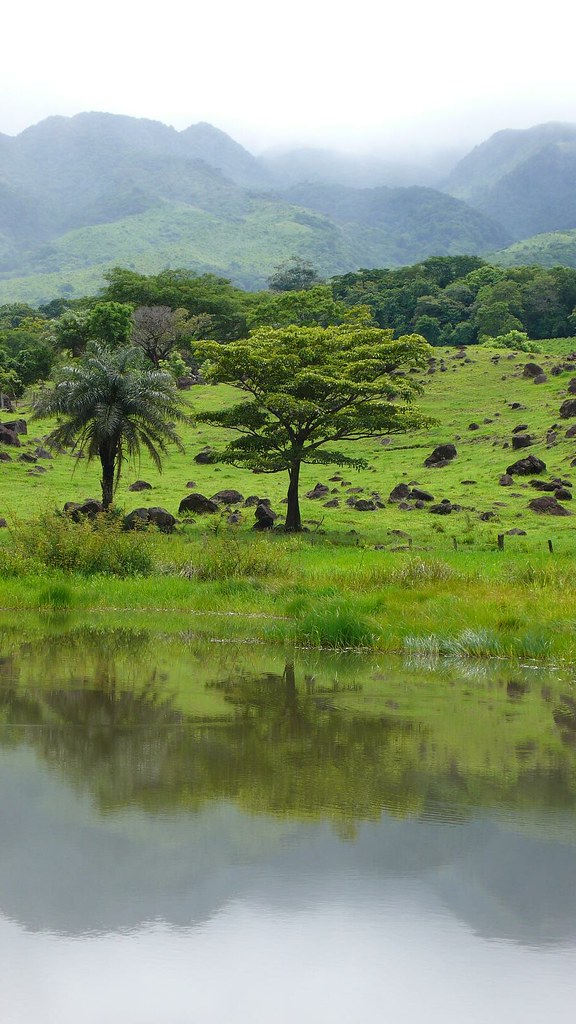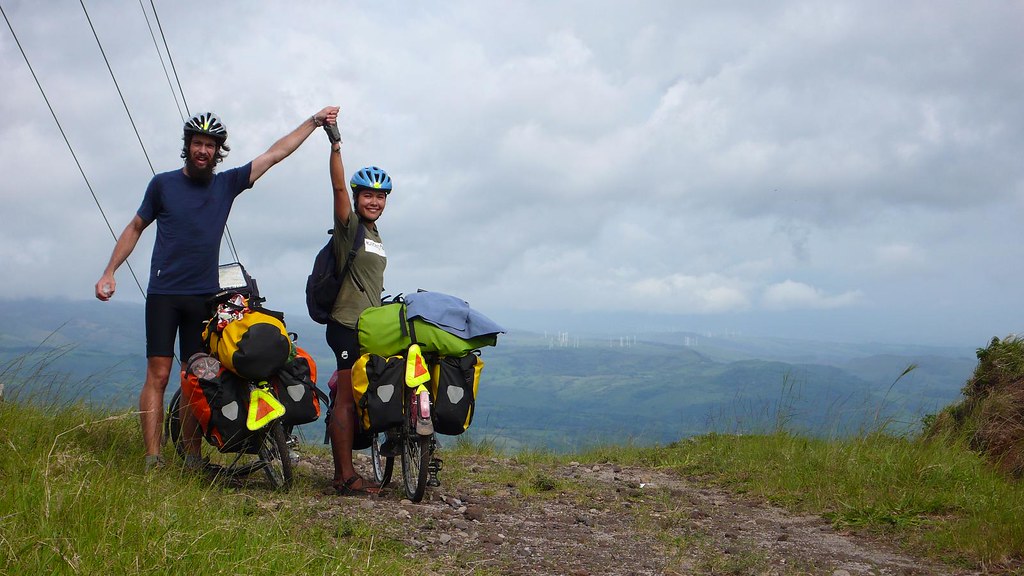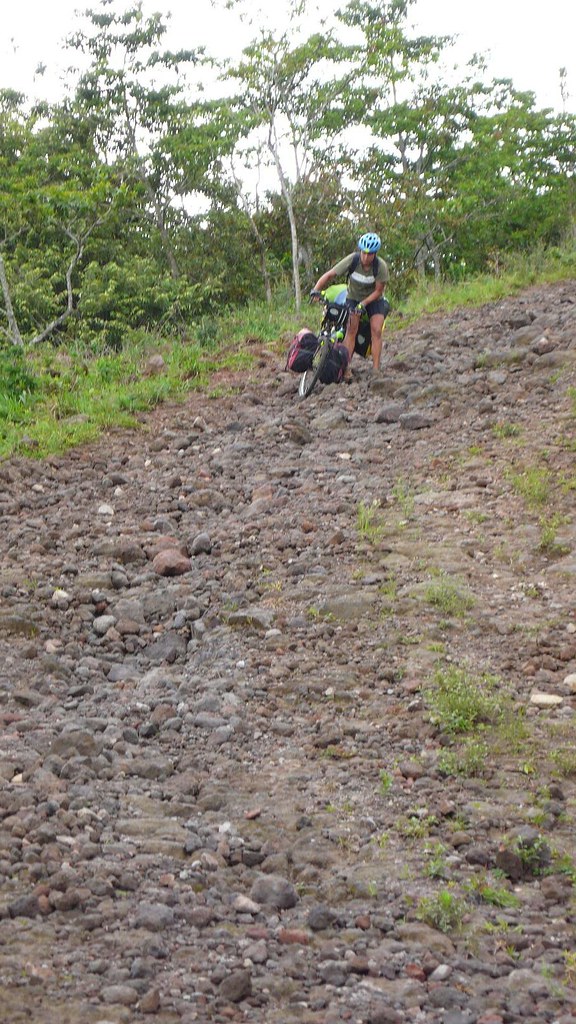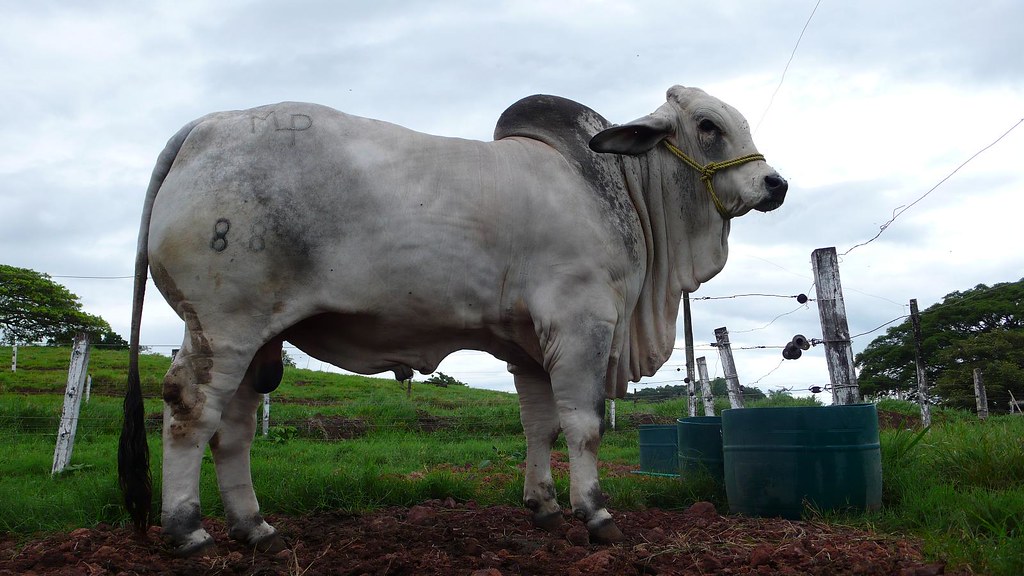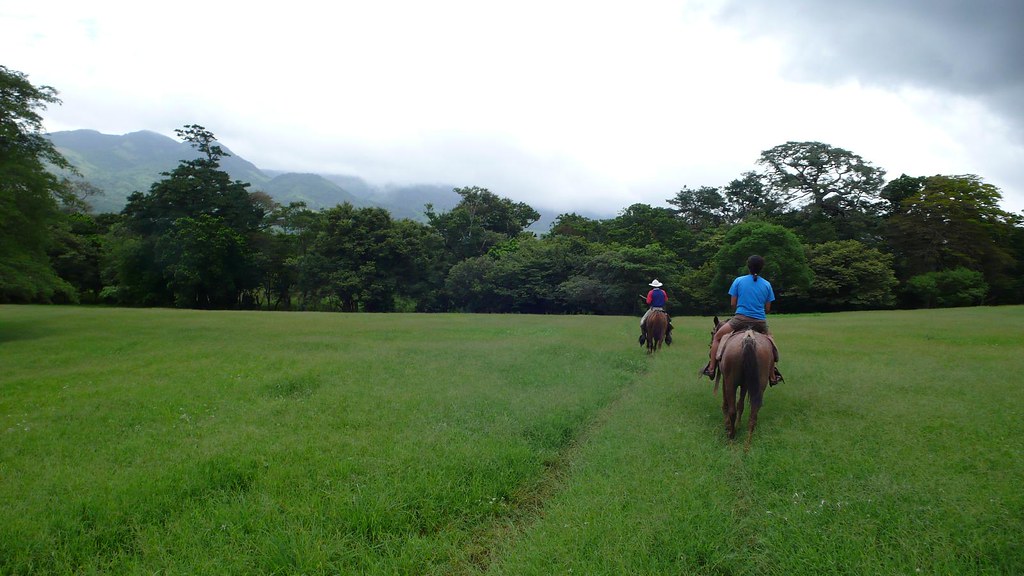But where to stash our bikes?...We had had good experiences with the police in Costa Rica and felt like we could probably trust them so we first went to the police station to hint around and see if they'd offer to let us keep our stuff there. They sort of picked up on the hints that we wanted to leave them there, but seemed a little reluctant. However, they did go around to the back of the station and ask a local handyman, named Alcides, who had a little warehouse back there, if he'd be willing to hold our stuff. He gladly agreed and I thought he looked honest, so we began to unload our stuff. This all happened in about 3 minutes and we we hardly had time to think about anything at all as we wanted to catch the next bus to Puerto Jimenez. Leah was a bit skeptical, especially since we had known the man a total of 2 minutes, but I had faith. As we unpacked under the blazing heat of his tin-roofed bodega, we made split second decisions of what to bring and not to bring and stressed at the same time about whether we were making a wise decision. Alcides told us of his friend in the Peace Corps that he had known and another bike tourist he had met before that had funny sized wheels that he couldn't find tires for and my confidence grew. When we finished and locked everything up, I was sweatier than I had gotten on the 50km ride on the Pacific coast that morning. We told him we would see him in a week and hurried off, coincidentally, to wait 3 hours for the really late bus.
The bus was standing room only so I stood almost the entire 2.5 hours (2 of them on bad dirt
 road). Leah was lucky enough to have an old gentleman call her over to make sure she got his seat when he got off about an hour into the trip. As we stared out the window at the PanAm highway which we'd have to bike later to get to Panama (we'd been able to avoid it in Costa Rica up until that point), Leah and I were quite frankly a little frightened at the prospect with it's lack of shoulder, windiness, and plethora of semis and crazy bus drivers (one of which was ours). We arrived into Puerto Jimenez at 10:30 at night and all the rooms in the town were booked, holiday goers were in town. We ended up in room (me on the floor) in an unfinished guesthouse on top of someone's house that we climbed up to on a makeshift ladder that I thought I was for sure going to break through with my heavy backpack on. In the morning, we went to make reservations for our trip and gather as much information as possible about the park as we were unable to obtain practically any consistent information prior about logistics.
road). Leah was lucky enough to have an old gentleman call her over to make sure she got his seat when he got off about an hour into the trip. As we stared out the window at the PanAm highway which we'd have to bike later to get to Panama (we'd been able to avoid it in Costa Rica up until that point), Leah and I were quite frankly a little frightened at the prospect with it's lack of shoulder, windiness, and plethora of semis and crazy bus drivers (one of which was ours). We arrived into Puerto Jimenez at 10:30 at night and all the rooms in the town were booked, holiday goers were in town. We ended up in room (me on the floor) in an unfinished guesthouse on top of someone's house that we climbed up to on a makeshift ladder that I thought I was for sure going to break through with my heavy backpack on. In the morning, we went to make reservations for our trip and gather as much information as possible about the park as we were unable to obtain practically any consistent information prior about logistics.The only consistent information we had was to make reservations at least a couple of weeks in advance, if not a month in the busy season. We had gone through a cycle numerous times to try and make reservations as follows: phone- website- email- no response- phone- email, etc. All of this energy resulted in bad information, faulty email addresses, a great amount of exasperation, and no reservations. We found out when we went into the office that the website is old and outdated, doesn't have the right email address published, and that reservations are not taken by phone, so basically, if you aren't going through a guide you can't make reservations unless you go
 into the office in Puerto Jimenez. They strongly recommended a guide for the route we (or shall I say, I) wanted to take, as well as for the rest of the park, of course. We were warned about poisonous snakes, peccaries (wild pigs) that would trample you in their herds of up to fifty and eat you on the spot, crocodiles and bull sharks at the river crossings (that we would have to cross), as well as headlands that could be dangerous at high tides. The very aloof and rarely seen jaguars and mountain lions were also a threat and finally there was the element of getting lost or suffering heatstroke. Well, they sufficiently scared Leah (all they really had to do was mention snakes), but I was more determined and excited than ever. We made our reservations (well, completed the first of the three step process) and left the office to walk across town to the bank to wait an hour in line to pay for our reservations. On the way, we approached to everyone that looked like they had hiked in the park to get the scoop from them. As our information databank grew, I was more and more convinced and Leah was starting to sway as well. Getting a guide was out of the question in my book, as it would cost over $200 for one day and someone we talked to said a guide told them $800 for the route we wanted to do! After the bank (step 2 complete), we went back to the office to complete the final step and validate our reservation. In so doing, we encountered Johannes and Stina, two German tourists, who were hoping to take the same route into the park that we wanted to. We made plans with them to maybe meet up later and do the hike in together.
into the office in Puerto Jimenez. They strongly recommended a guide for the route we (or shall I say, I) wanted to take, as well as for the rest of the park, of course. We were warned about poisonous snakes, peccaries (wild pigs) that would trample you in their herds of up to fifty and eat you on the spot, crocodiles and bull sharks at the river crossings (that we would have to cross), as well as headlands that could be dangerous at high tides. The very aloof and rarely seen jaguars and mountain lions were also a threat and finally there was the element of getting lost or suffering heatstroke. Well, they sufficiently scared Leah (all they really had to do was mention snakes), but I was more determined and excited than ever. We made our reservations (well, completed the first of the three step process) and left the office to walk across town to the bank to wait an hour in line to pay for our reservations. On the way, we approached to everyone that looked like they had hiked in the park to get the scoop from them. As our information databank grew, I was more and more convinced and Leah was starting to sway as well. Getting a guide was out of the question in my book, as it would cost over $200 for one day and someone we talked to said a guide told them $800 for the route we wanted to do! After the bank (step 2 complete), we went back to the office to complete the final step and validate our reservation. In so doing, we encountered Johannes and Stina, two German tourists, who were hoping to take the same route into the park that we wanted to. We made plans with them to maybe meet up later and do the hike in together.The commitment from Johannes and Stina to do the hike with us finally put Leah over the edge into the "yes zone". It was a go and I was excited. We camped the night at Danta Corcovado Lodge, a beautiful eco-lodge on the way to the trail where we would begin at day break the following morning. We opted to take horses and a guide for the first 14 km of the trail as it crossed the river 10-15 times and was reportedly the hardest part, trail-finding-wise. Not to mention it reduced the length of our hike from 34km to 20km making it doable in one day, as there is no designated camping area on the way and walking at night is the most dangerous part of being in the forest. I would have been stoked to camp in the middle of the forest, but I don't like breaking rules and there is certainly the scary element of the unknown.
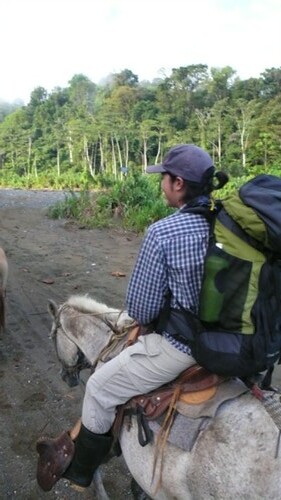 The horse back ride ended up being worth every penny of it. The great thing about being on a horse is that you don't have to look on the ground where you are placing your feet and you can just absorb everything around you and zone out in the sounds, smells, and sights. The river that our horses followed was in a valley and we saw many kinds of birds fly overhead including the Scarlet Macaw. Rosa and Macho, our horses, did well taking us and our backpacks with few complaints. We arrived at the Los Patos station at about 9 AM, but didn't set off on the trail until 10:30 as we had to register at the station, then walk 3 km uphill to the old station where the trailhead was located, and also eat some breakfast.
The horse back ride ended up being worth every penny of it. The great thing about being on a horse is that you don't have to look on the ground where you are placing your feet and you can just absorb everything around you and zone out in the sounds, smells, and sights. The river that our horses followed was in a valley and we saw many kinds of birds fly overhead including the Scarlet Macaw. Rosa and Macho, our horses, did well taking us and our backpacks with few complaints. We arrived at the Los Patos station at about 9 AM, but didn't set off on the trail until 10:30 as we had to register at the station, then walk 3 km uphill to the old station where the trailhead was located, and also eat some breakfast.The forest canopy shaded us the entire 20km from Los Patos to Sirena making the weather quite pleasant. We walked at a fast but steady pace with few breaks as we knew the sun went down around 5:30 and we had a 6-8 hour hike ahead of us. Unfortunately, because we had to walk so briskly we weren't able to stop and look for sloths or other wildlife high up in the trees. However, we did see a ton of spider monkeys and squirrel monkeys taunting us from the treetops. A couple of which got directly above us and started shaking the branches and trees as if to shower us with leaves and and fruits (successfully). We had also heard that peccaries are usually smelled before they are seen as they have a horrible stench. About three hours into our hike, we all stopped in our tracks at the same time and looked at each other with the same recognition in our eyes...peccary stench. All of our sources on peccarries said the same thing, watch out, stay away and get ready to run and climb a tree or get on something at least 4 feet high. I got out my machete and the others grabbed big sticks, and we all unclipped our backpacks and looked for the nearest good climbing tree (not many of those in a forest where the canopy is over 75 feet overhead) if the peccaries made their presence known. Lucky for us, we saw no hide nor hair of them (just a ton of tracks) and continued on slowly, sniffing along the way. Finally, three easy river crossings and 6.5 hours later we arrived at the Sirena ranger station. Leah walked the entire way in a pair of thick rubber boots (the kind that all of the local laborers wear) which eased her fear of getting bit by a snake, and at the end she didn't even have one blister.
"Camping" at Sirena was plush. We had a huge covered patio to sleep on with foam mats provided, so all we really needed was to put up our tent to act as a mosquito net. Over the next
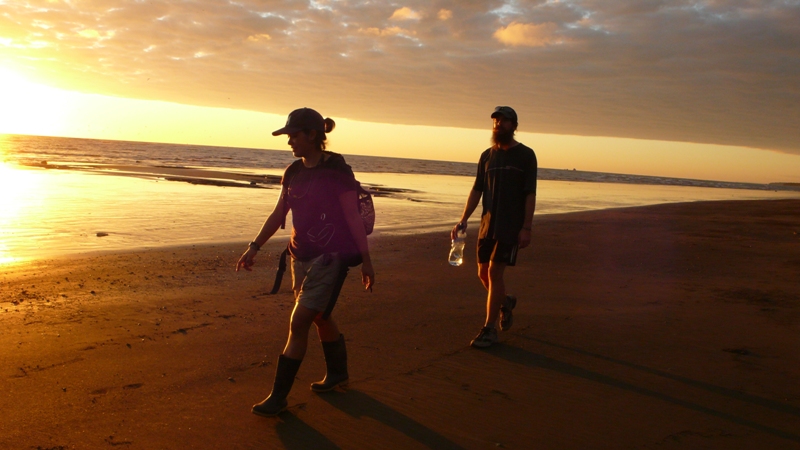 three days, we explored the trails and beach surrounding Sirena and happened upon a number of cool sites. One afternoon we went to a mudhole where a tapir was reported to frequent often. We saw the tapir resting deep in the mud and then to our surprise the tapir stood up, crawled out of the mudhole and started walking toward the beach. We followed and when we got to the beach, there was another tapir traipsing along. Tapirs are much larger than I thought and are actually about the size of a small pony with tracks the size of a small elephants. It was truly spectacular to enjoy a sunset walk in the company of two tapirs.
three days, we explored the trails and beach surrounding Sirena and happened upon a number of cool sites. One afternoon we went to a mudhole where a tapir was reported to frequent often. We saw the tapir resting deep in the mud and then to our surprise the tapir stood up, crawled out of the mudhole and started walking toward the beach. We followed and when we got to the beach, there was another tapir traipsing along. Tapirs are much larger than I thought and are actually about the size of a small pony with tracks the size of a small elephants. It was truly spectacular to enjoy a sunset walk in the company of two tapirs. Our regular alarm clock at 5:30, just before sunset became the T-Rex sounding call of the local howler monkeys, we never saw them however as they kept quite during the day. Squirrel monkeys and spider monkeys were also a common sight near our sleeping area. One morning after breakfast, we looked up to see a teeny tiny baby spider monkey clinging to it's mothers belly. Never seen such a tiny monkey, it looked like it could fit in the palm of my hand. At the river mouth of Rio Sirena, we immediately noticed the predators that lurked and it was no longer a mystery to us why NO ONE crosses the river, even at low tide. We had a couple of guides tell us that they wouldn't even put a toe in that river.
Our regular alarm clock at 5:30, just before sunset became the T-Rex sounding call of the local howler monkeys, we never saw them however as they kept quite during the day. Squirrel monkeys and spider monkeys were also a common sight near our sleeping area. One morning after breakfast, we looked up to see a teeny tiny baby spider monkey clinging to it's mothers belly. Never seen such a tiny monkey, it looked like it could fit in the palm of my hand. At the river mouth of Rio Sirena, we immediately noticed the predators that lurked and it was no longer a mystery to us why NO ONE crosses the river, even at low tide. We had a couple of guides tell us that they wouldn't even put a toe in that river. 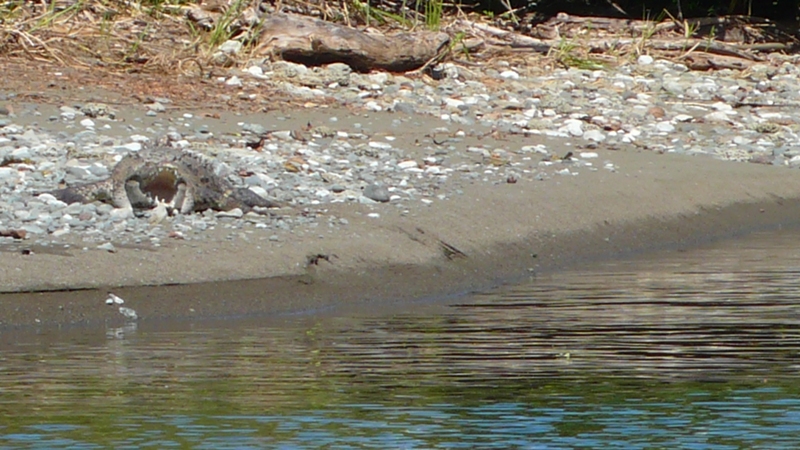 Two large crocs basked on the shore while one patroled the inside of the river mouth and the bull shark fins patrolling the ocean and river waters where plentiful. We watched one of the crocs enter the water, but then we lost him and weren't able to see him anymore...until we began walking back along the beach. He was swimming in the ocean! Not even that close to the river mouth anymore. The croc was just cruising along in the waves parallelling the beach, looking for some dinner presumably, if we hadn't known anybetter we'd have sworn it was a log. Crocs in the ocean and sharks in the river...go figure.
Two large crocs basked on the shore while one patroled the inside of the river mouth and the bull shark fins patrolling the ocean and river waters where plentiful. We watched one of the crocs enter the water, but then we lost him and weren't able to see him anymore...until we began walking back along the beach. He was swimming in the ocean! Not even that close to the river mouth anymore. The croc was just cruising along in the waves parallelling the beach, looking for some dinner presumably, if we hadn't known anybetter we'd have sworn it was a log. Crocs in the ocean and sharks in the river...go figure.We took a short hike with some of the other "campers" at Sirena to the only repotedly safe place
 to swim near Sirena, up the Rio Claro, and relished in the relief from the humidity and heat of the area. As a group we comprised a varied group from different parts in Canada, the US, and France. We even met another Hawaii native who graduated from high school the same year as Leah, just across the island. We enjoyed getting to know everyone and exploring the surroundings with more eager eyes than just our own. We did not however, enjoy our meals much. Our diet consisted mainly of peanut butter, honey and tortillas as we had not brought our stove in the interest of sacing weight. Johannes and Stina did however treat us to some freeze dried meals a couple of times, those were really special meals!
to swim near Sirena, up the Rio Claro, and relished in the relief from the humidity and heat of the area. As a group we comprised a varied group from different parts in Canada, the US, and France. We even met another Hawaii native who graduated from high school the same year as Leah, just across the island. We enjoyed getting to know everyone and exploring the surroundings with more eager eyes than just our own. We did not however, enjoy our meals much. Our diet consisted mainly of peanut butter, honey and tortillas as we had not brought our stove in the interest of sacing weight. Johannes and Stina did however treat us to some freeze dried meals a couple of times, those were really special meals!There were two other couples leaving Sirena to hike out to Carate the same day as us, so we arranged to all hike together: Wilfred and Holly, a father and daughter who live on the Osa Peninsula, and Stephanie and Olivier, a French couple on their honeymoon. The hike to Carate was also 20km, but this time along the beach. We left at 5:45 am to try and avoid the heat and also to ensure that we'd cross the Rio Claro at a low enough tide to avoid shark and croc bites. Along the way, we saw some coatis, scarlet macaws, an agouti and of course more playful monkeys. Thankfully, no snakes, sharks, or crocs.
 The beach vistas were postcard perfect and the flat 20km went by before we knew it. The last 4 km we walked barefoot on the wet sand with an occasional splash from a bigger wave. Although we did escape most of the heat by leaving early, we didn't anticipate having to wait in Carate for four hours for the collectivo to take us back to Puerto Jimenez. Carate was just a small store with expensive drinks and a few hotels. As you can imagine, we got to know our hiking companions a bit better and played some cards to pass the time. When we finally got back to Puerto Jimenez, the first thing on our minds was a hot meal and a beer, two luxuries we hadn't had in almost a week.
The beach vistas were postcard perfect and the flat 20km went by before we knew it. The last 4 km we walked barefoot on the wet sand with an occasional splash from a bigger wave. Although we did escape most of the heat by leaving early, we didn't anticipate having to wait in Carate for four hours for the collectivo to take us back to Puerto Jimenez. Carate was just a small store with expensive drinks and a few hotels. As you can imagine, we got to know our hiking companions a bit better and played some cards to pass the time. When we finally got back to Puerto Jimenez, the first thing on our minds was a hot meal and a beer, two luxuries we hadn't had in almost a week.We hit it off with Olivier and Stephanie and ended up spending the next three nights and subsequently, Christmas with them. We shared laughs, games, stories, jokes, Christmas traditions (in France the eat fatty liver...mmm), taxi rides, food, beers, rum, Christmas dinner of fried fish and plantains and even went out dancing at the local discotech on Christmas eve (a first for all of us). It didn't really feel like Christmas to any of us but it was definitely a memorable time for all. Leah and I also had the pleasure of talking with most of our family members on Christmas day which was nice.
 On the 26th we got on the bus to head back to Palmar Norte to discover if our bikes were indeed still in Alcidez's bodega behind the police station and resume cycling again. We said sad goodbyes with our new close friends as we got off the bus and they continued north. There wasn't much time to mope around however as we had to get back to our bikes and pack everything up for our journey up and into the Talamanca mountains on our way to Panama!
On the 26th we got on the bus to head back to Palmar Norte to discover if our bikes were indeed still in Alcidez's bodega behind the police station and resume cycling again. We said sad goodbyes with our new close friends as we got off the bus and they continued north. There wasn't much time to mope around however as we had to get back to our bikes and pack everything up for our journey up and into the Talamanca mountains on our way to Panama!





































